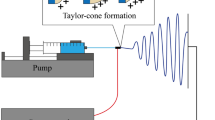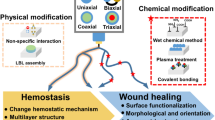Abstract
The development of bioreactors for tissue engineered heart valves would be aided by a thorough understanding of how mechanical forces impact cells within valve leaflets. The hypothesis of the present study is that flow may influence the biosynthetic activity of aortic valve leaflet cells. Porcine leaflets were exposed to one of several conditions for 48 h, including steady or pulsatile flow in a tubular flow system at 10 or 20 l/min, and steady shear stress in a parallel plate flow system at 1, 6, or 22 dyne/cm2. Protein, glycosaminoglycan, and DNA synthesis increased during static incubation but remained at basal levels after exposure to flow. The modulation of synthetic activity was attributed to the presence of a shear stress on the leaflet surface, which may be transmitted to cells within the leaflet matrix through tensile forces. The α-smooth muscle (α-SM) actin distribution observed in fresh leaflets was proportionately decreased after exposure to antibiotics and not recovered by either static incubation or exposure to flow. These results indicate that exposure to flow maintains leaflet synthetic activity near normal levels, but that the inclusion of another force, such as bending or backpressure, may be necessary to preserve α-SM actin immunoreactive cells. © 2001 Biomedical Engineering Society.
PAC01: 8780Rb, 8719Hh, 8719Uv, 8715Rn, 8768+z, 8719Ff, 8714Gg, 8714Ee
Similar content being viewed by others
References
Bairati, A., and S. DeBiasi. Presence of a smooth muscle system in aortic valve leaflets. Anat. Embryol.161:329–340, 1981.
Buckwalter, J. A., Articular cartilage. Part I. Tissue design and chondrocyte-matrix interactions.J. Bone Jt. Surg. 79:600–611, 1997.
Chen, A. C., and R. L. Sah. Effect of static compression on proteoglycan biosynthesis by chondrocytes transplanted to articular cartilage in vitro. J. Orthop. Res.16:542–550, 1998.
Crescenzo, D. G., S. L. Hilbert, R. H. Messier, P. W. Domkowski, M. K. Barrick, P. L. Lange, V. J. Ferrans, R. B. Wallace, and R. A. Hopkins. Human cryopreserved homografts: Electron microscopic analysis of cellular injury. Ann. Thorac. Surg.55:25–31, 1993.
Galea, J., J. Armstrong, S. E. Francis, G. Cooper, D. C. Grossman, and C. M. Holt. Alterations in c-fos expression, cell proliferation and apoptosis in pressure distended human saphenous vein. Cardiovasc. Res.44:436–448, 1999.
Galietta, L. J., S. Lantero, A. Gazzolo, O. Sacco, L. Romano, G. A. Rossi, and O. Zegarra-Moran. An improved method to obtain highly differentiated monolayers of human bronchial epithelial cells. In Vitro Cell. Dev. Biol. Anim.34:478–481, 1998.
Gray, M. L., A. M. Pizanelli, R. C. Lee, A. J. Grodzinsky, and D. A. Swann. Kinetics of the chondrocyte biosynthetic response to compressive load and release. Biochim. Biophys. Acta991:415–425, 1989.
Hoerstrup, S. P., R. Sodian, J. S. Sperling, D. P. Martin, F. J. Schoen, J. P. Vacanti, and J. E. Mayer. A trileaflet heart valve grown in vitro [abstract]. Circulation100suppl I:I527–528, 1999.
Hogg, N., J. Browning, T. Howard, C. Winterford, D. Fitzpatrick, and G. Gobe. Apoptosis in vascular endothelial cells caused by serum deprivation, oxidative stress and transforming growth factor-beta. Endothelium7:35–49, 1999.
Ingber, D. E.Tensegrity: The architectural basis of cellular mechanotransduction. Annu. Rev. Physiol.59:575–599, 1997.
Jouret, C. Effects of Matrix and Phenotype on Human Dermal Fibroblast Attachment Under Laminar Shear Stress: Implications for the Development of Tissue-Engineered Heart Valves. MS thesis. Atlanta, GA: Georgia Institute of Technology, 1997.
Leeson-Dietrich, J., D. Boughner, and I. Vesely. Porcine pulmonary and aortic valves: A comparison of their tensile viscoelastic properties at physiological strain rates. J. Heart Valve Dis.4:88–94, 1995.
Levesque, M. J., and R. M. Nerem. The elongation and orientation of cultured endothelial cells in response to shear stress. J. Biomech. Eng.107:341–347, 1985.
McGiffin, D. C., M. F. O'Brien, E. G. Stafford, M. A. Gardner, and P. G. Pohlner. Long-term results of the viable cryopreserved allograft aortic valve: Continuing evidence for superior valve durability. J. Card. Surg.3Suppl:289–296, 1988.
McIntire, L. V., Bioengineering and vascular biology. Ann. Biomed. Eng.22:2–13, 1994.
Messier, R. H., B. L. Bass, H. M. Aly, J. L. Jones, P. W. Domkowski, R. B. Wallace, and R. A. Hopkins. Dual structural and functional phenotypes of the porcine aortic valve interstitial population: Characteristics of the leaflet myofibroblast. J. Surg. Res.57:1–21, 1994.
Messier, R. H., P. W. Domkowski, H. M. Aly, A. S. Abd-Elfattah, D. G. Crescenzo, R. B. Wallace, and R. A. Hopkins. High energy phosphate depletion in leaflet matrix cells during processing of cryopreserved cardiac valves. J. Surg. Res.52:483–488, 1992.
Muller, G., A. Muller, H. Jonuleit, K. Steinbrink, C. Szalma, L. Paragnik, K. Lingnau, E. Schmidt, J. Knop, and A. H. Enk. Fetal calf serum-free generation of functionally active murine dendritic cells suitable for in vivo therapeutic approaches. J. Invest. Dermatol.114:142–149, 2000.
Niklason, L. E., J. Gao, W. M. Abbott, K. K. Hirschi, S. Houser, R. Marini, and R. Langer. Functional arteries grown in vitro. Science284:489–493, 1999.
O'Brien, M. F., G. Stafford, M. Gardner, P. Pohlner, D. McGiffin, N. Johnston, A. Brosnan, and P. Duffy. The viable cryopreserved allograft aortic valve. J. Card. Surg.2Suppl:153–167, 1987.
Ott, M. J., and B. J. Ballermann. Shear stress-conditioned, endothelial cell-seeded vascular grafts: Improved cell adherence in response to in vitro shear stress. Surgery (St. Louis)117:334–339, 1995.
Quick, D. W., K. S. Kunzelman, J. M. Kneebone, and R. P. Cochran. Collagen synthesis is upregulated in mitral valves subjected to altered stress. ASAIO J.43:181–186, 1997.
Reinhart, W. H.Shear dependence of endothelial functions. Experientia50:87–93, 1994.
Ross, D.Pulmonary valve autotransplantation (the Ross operation). J. Card. Surg.3Suppl:313–319, 1988.
Saini, S., and T. M. Wick. Bioreactor characterization and optimization for cartilage tissue engineering. In: Proceedings of the First Joint Meeting of BMES & EMBS, Abstract 1.4.2.6. Atlanta, GA, 1999 (CD ROM published by IEEE).
Schneider, P. J., and J. D. Deck. Tissue and cell renewal in the natural aortic valve of rats: An autoradiographic study. Cardiovasc. Res.15:181–189, 1981.
Seliktar, D., R. A. Black, R. P. Vito, and R. M. Nerem. Dynamic mechanical conditioning of collagen-gel blood vessel constructs induces remodeling in vitro. Ann. Biomed. Eng.28:351–362, 2000.
Shinoka, T., P. X. Ma, D. Shum-Tim, C. K. Breuer, R. A. Cusick, G. Zund, R. Langer, J. P. Vacanti, and J. E. Mayer. Tissue engineered heart valves: Autologous valve replacement study in a lamb model. Circulation94suppl II:II164–168, 1996.
Thubrikar, M. J. The Aortic Valve. Boca Raton, FL: CRC, 1991.
Vanhee, C. Influence of Shear Stress on Cell Proliferation and on Protein Kinase C Localization in an Anchorage-Dependent Mammalian Cell Line. MS thesis. Atlanta, GA: Georgia Institute of Technology, 1991.
Vesely, I., and R. Noseworthy. Micromechanics of the fibrosa and the ventricularis in aortic valve leaflets. J. Biomech.25:101–113, 1992.
Weston, M. W. Characterization of the Shear Stress on the Aortic Valve Leaflet Surface and Its Effects on Cellular Biosynthetic Activity. PhD thesis. Atlanta, GA: Georgia Institute of Technology, 2000.
Weston, M. W., D. V. LaBorde, and A. P. Yoganathan. Estimation of the shear stress on the surface of an aortic valve leaflet. Ann. Biomed. Eng.27:572–579, 1999.
Weston, M. W., S. Goldstein, R. E. Epting, S. He, J. M. Mauldin, and A. P. Yoganathan. Establishing a protocol to quantify leaflet fibroblast responses to physiologic flow through a viable heart valve. ASAIO J.43:M377–382, 1997.
Willems, I. E. M. G., M. G. Havenith, J. F. M. Smits, and M. J. A. P. Daemen. Structural alterations in heart valves during left ventricular pressure overload in the rat. Lab. Invest.71:127–133, 1994.
Author information
Authors and Affiliations
Rights and permissions
About this article
Cite this article
Weston, M.W., Yoganathan, A.P. Biosynthetic Activity in Heart Valve Leaflets in Response to In Vitro Flow Environments. Annals of Biomedical Engineering 29, 752–763 (2001). https://doi.org/10.1114/1.1397794
Issue Date:
DOI: https://doi.org/10.1114/1.1397794




